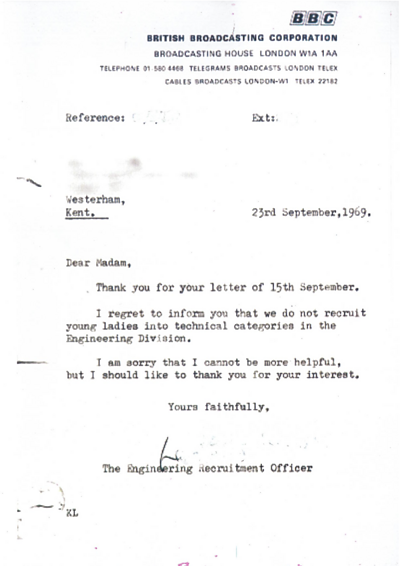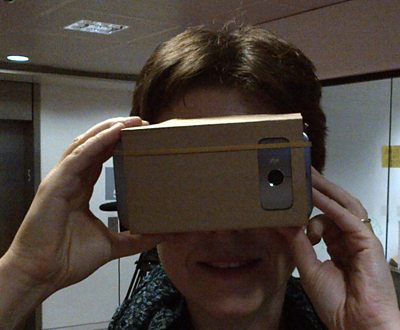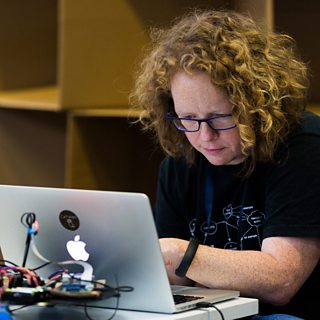Regular updates from the Internet Research & Future Services team in Βι¶ΉΤΌΕΔ R&D, making new things on the internet. You can follow us on Twitter at @bbcirfs.
Here's a letter written to a woman looking for a job in engineering at the Βι¶ΉΤΌΕΔ in 1969. More information is . Things have moved on somewhat, as Rob explains below.

Hello / Goodbye / Congratulations
This week we said a sad farewell to Tim, who had his last day of his attachment with us, and then headed back to the UX mothership. We welcome Malin, who joins IRFS as our new Senior Creative Director, replacing the much-missed Theo; David, who joins the discovery team as Creative Director; Georgios, who will work for a few months on cross-linking and recommendation engines; and welcome back Kat, rejoining IRFS to manage the discovery team project's external sources. And congratulations are due to Jiri on passing his MSc with with merit. Congratulations Jiri!
Classification and gender
Rob, Jana and James have been working on a paper around male/female classifier for speech radio, and also finishing off a final proposal with Cardiff School of Journalism around some media monitoring work which would allow us to do large scale monitoring of such things as gender balance in broadcast output (some evidence at least that R&D ).
Andrew McP arranged for the Data team and Denise to present our work on metadata extraction/mood/archive search to a delegation of Japanese academics and media execs brought over to the UK by the Japanese Embassy.
Physical Web
arranged a flying visit from Scott Jenson, to talk about Scott's , which connects nicely to our recent thinking around connecting and personalising media devices in a featherweight temporary way using Bluetooth LE and NFC.
Radiodan testing and art
Joanne and AndrewW, Dan and AndrewN have been participating in a Radiodan home trial designed by Joanne. We've learned a lot from the trial, particularly around communicating error states during the wifi connection process. Dan and AndrewN also found time to build a physical, interactive map of global live radio with artists and together with our Βι¶ΉΤΌΕΔ colleagues Matt Paradis and Pete Warren. More on this in a future post.
Planning
Tristan, ChrisG and Zillah have all been planning and thinking about the future: Tristan with the Content team, Radiodan, Comma, and the World Service Archive; Zillah and ChrisG about aspects of the Archers prototype and continuity database. The devices team attended ChrisG's landscape mapping session on Radiodan - Chris says: "some great ideas of where to take it next, just got to choose which one(s)".
Zillah's also been talking to people about immersive news, and VR on phones, and also attended her first UK Radio Archives Advisory Committee, at the British Library.

Product design and creativity
I'm preparing to run a workshop this week with Radio and Music and so have been thinking about creativity and product design. Digging around Scott's site I found , about getting out of the normal mindset, this time with respect to the Internet of Things. You need to get out of that mindset to explore the potential product space: two articles describing that space from two very thoughtful people also came my way this week: and . I also read The Myths of Innovation by - he argues that ideas typically get shut down too fast (suggesting perhaps, that many parts of product space are never reached). He also talks about Alex Osborn, inventor of the process and term 'brainstorming', who thought that unless you were outrageous, embarrassing, illogical, and unpredictable when brainstorming, you weren't doing it right.
Recommendations
Chris Newell and Fabian have been exploring the landscape of recommendations in various ways. Chris has been exploring techniques for forecasting future audience levels from past behaviour. The initial results indicate that this is relatively easy to do for established programmes but more challenging for new programmes. A similar issue is experienced in recommender systems, from which we may be able to borrow ideas for potential solutions. With Fabian, our visiting MSc student from the University of Zurich, he has extended the MyMediaLite Recommender System library with a set of diversity metrics. One metric, that they call "surprisal", measures the capability of an algorithm to recommend not only the very popular items, which is most likely of little use for a user, but also e.g. TV shows with only few views. Current graph based techniques perform poorly on this metric, but, surprisally, they have found an extension to the algorithms that improves surprisal but also unexpectedly improves accuracy. But you'll have to wait for Fabian to write up his results for his thesis before we tell you what it is.
Standards
Chris Needham and Sean attended the latest meeting of the , hosted by . Chris presented the work that Thomas and he did adapting CPA to the browser-based connected TV environment, which we plan to be the basis of an HbbTV compatible authentication protocol.
Olivier spent a good chunk of last week in a hazy, jet-lagged state after a successful . Follow-up work included a meeting with some of our colleagues from R&D and MyΒι¶ΉΤΌΕΔ, looking at different facets of work on privacy, data retention and portability, etc.
Open Source
Thomas presented the story and what we learned from it about how to do successful open source work at the Βι¶ΉΤΌΕΔ at the conference in London. It has been recorded and the video should soon be public.
Experimental persuasion techniques
In a small experiment I discovered that SHOUTING FOR WEEKNOTES is more effective than asking politely.
(more) links
From Tristan - " is an online platform game, made by Drum Roll, that teaches kids to code and create on the web. It does this in a unique way - by encouraging them to hack into levels, written in HTML and CSS (the languages of websites) - in order to complete the game." and also
Zillah suggests: "if you get a chance, listen to this . I was captivated. And I hope we are all as spritely at 95." She also liked - type in words, and it will find video to match.
Jiri's is open for participation. He also found a and some
Thomas liked and
Ant: is a twitter bot that automatically creates low polygon pictures from any image it gets sent. This is a . He also suggested - he found the designer's story inspirational
I really liked Scott Jenson's - thinking about the potential of mobile phones beyond apps.
